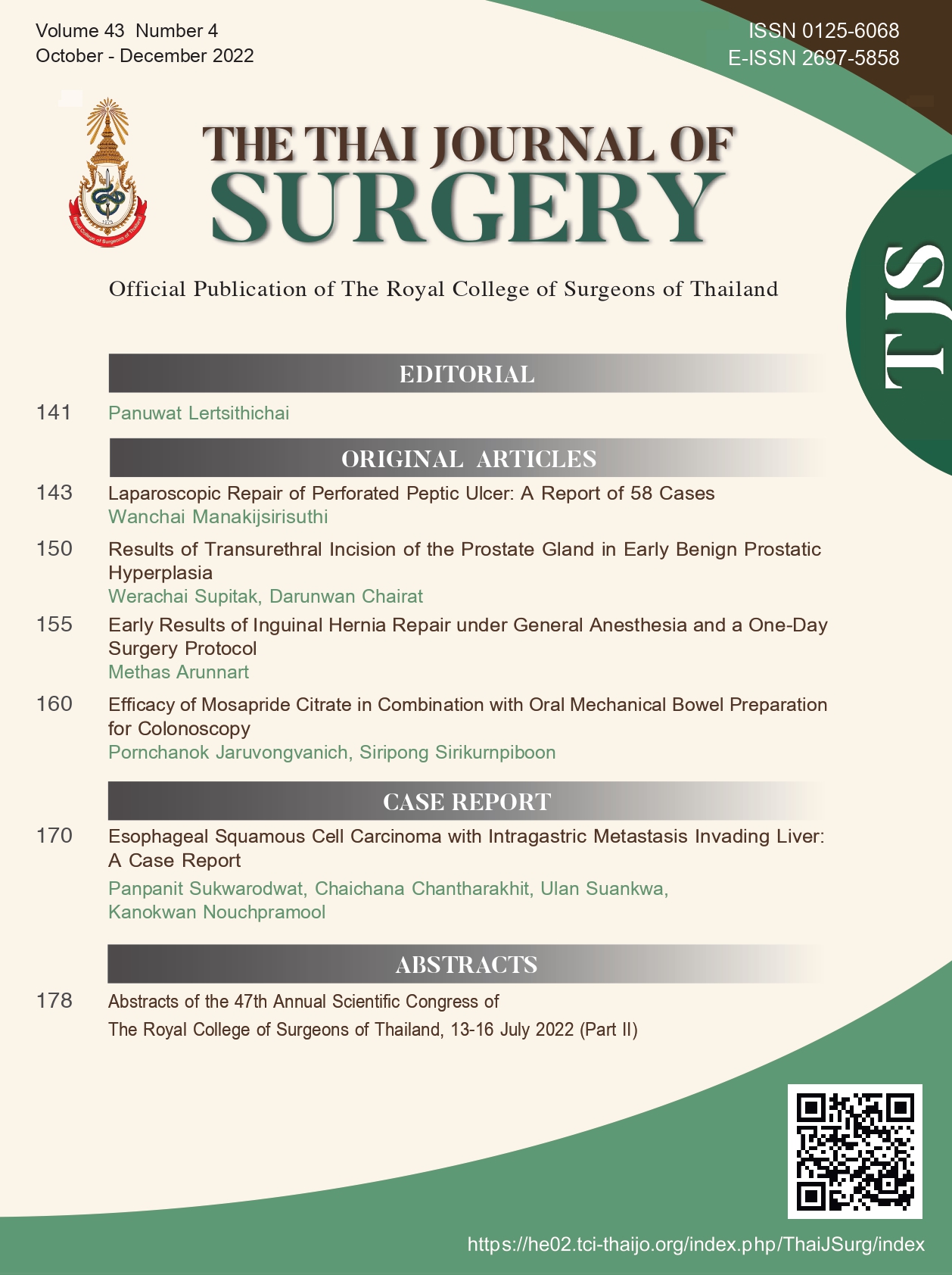Laparoscopic Repair of Perforated Peptic Ulcer: A Report of 58 Cases
Keywords:
Perforated peptic ulcer, Laparoscopic repair, Simple closure, Site leakAbstract
Objective: The most common cause of gastroduodenal perforation is a perforated peptic ulcer (PPU). Laparoscopic repair has proved to be beneficial over open repair in terms of less post-op pain and a shorter length of stay. However, complications from site leak and intra-abdominal abscess are more common. The author reported the outcomes of three laparoscopic repair procedures: simple closure alone (SC), simple closure with omental patch (SCO), and simple closure alone with leak test (SCL) in 58 patients who presented with perforated gastroduodenal lesions.
Methods: Between July 2011 and October 2020, retrospective data of 58 patients with gastroduodenal perforation and underwent SC, SCO, and SCL were analyzed.
Results: There were 57 benign peptic ulcers and 1 gastric cancer perforation. Laparoscopic surgery was accomplished in 52 cases (89.7%) and was converted to open surgery in 6 cases (10.3%). SCO was performed in 13 cases (22.4%), SC in 15 cases (25.9%) and SCL in 24 cases (41.4%). In the SCL group, wound leakage was detected in 2 cases (8.3%) and both were corrected intra-operatively. There was no site leak or intra-abdominal abscess in this study, and no re-operation was required. Two deaths (3.4%) were found in this study.
Conclusion: SCO for large ulcers was a safe procedure but took longer operative time. SC for small ulcer was secure with shorter operative time. SCL for high-risk ulcers could detect site leak intra-operatively and could prevent post-operative complications.
References
Lau JY, Sung J, Hill C, et al. Systematic review of the epidemiology of the complicated peptic ulcer disease: incidence, recurrence, risk factors and mortality: Digestion 2011;84:102-13.
Lolle I, Møller MH, Rosenstock SJ. Association between ulcer site and outcome in complicated peptic ulcer disease: a Danish nationwide cohort study. Scand J Gastroenterol 2016;51:1165-71.
Pansa A, Kurihara H, Memon MA. Updates in laparoscopic surgery for perforated peptic ulcer disease: state of the art and future perspectives. Ann Laparosc Endosc Surg 2020;5:5.
Pan CW , Liou LR , Mong FY, et al. Simple laparoscopic repair of perforated peptic ulcer without omental patch. Asian J Surg 2020; 43:311-4.
Ministry of Public Health. Thailand Health Profile Report 2005-2007.
Higham J, Kang JY, Majeed A. Recent trends in admissions and mortality due to peptic ulcer in England: increasing frequency of haemorrhage among older subjects. Gut 2002;50:460-4.
Noguiera C, Silva AS, Santos JN, et al. Perforated peptic ulcer: main factors of morbidity and mortality. World J Surg 2003;27:782-7.
Canoy DS, Hart AR, Todd CJ. Epidemiology of duodenal ulcer perforation: a study on hospital admissions in Norfolk, United Kingdom. Dig Liver Dis. 2002;34:322-7.
Suriya C, Kasatpibal N, Kunaviktikul W, et al. Diagnostic indicators for peptic ulcer perforation at a tertiary care hospital in Thailand. Clin Exp Gastroenterol 2011;4:283–9.
Mariëtta J, Bertleff OE, Lange JF. Laparoscopic correction of perforated peptic ulcer: first choice? A review of literature. Surg Endosc 2010;24:1231–9.
Kim HC, Yang DM, Kim SW, et al. Gastrointestinal tract perforation: evaluation of MDCT according to perforation site and elapsed time. Eur Radiol 2014;24:1386-93.
Ates M, Coban S, Sevil S, et al. The efficacy of laparoscopic surgery in patients with peritonitis. Surg Laparosc Endosc Percutan Tech 2008;18:453-6.
Agresta F, Mazzarolo G, Ciardo LF, et al. The laparoscopic approach in abdominal emergencies: has the attitude changed? A single-center review of a 15-year experience. Surg Endosc 2008;22:1255-62.
Manakijsirisuthi W. Early postoperative feeding after gastroduodenal operation: A 72 cases report. SMJ 2002;54:387-93.
Manakijsirisuthi W. Laparoscopic treatment of cholecystoduodenal fistula: A case report. Thai J Surg 2019;40:22-5.
Downloads
Published
How to Cite
Issue
Section
License
Copyright (c) 2022 The Royal College of Surgeons of Thailand

This work is licensed under a Creative Commons Attribution-NonCommercial-NoDerivatives 4.0 International License.
Articles must be contributed solely to The Thai Journal of Surgery and when published become the property of the Royal College of Surgeons of Thailand. The Royal College of Surgeons of Thailand reserves copyright on all published materials and such materials may not be reproduced in any form without the written permission.



